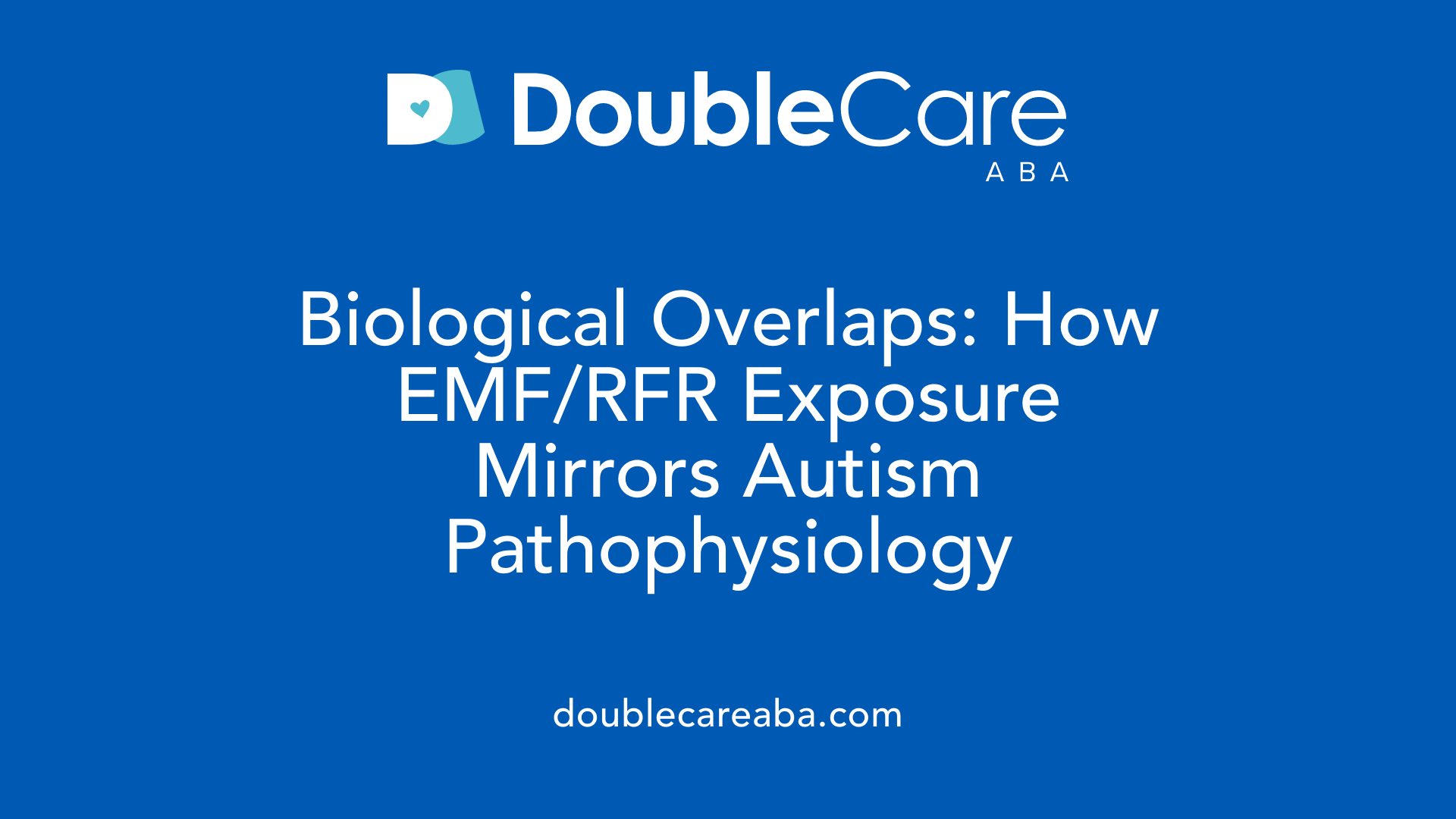Understanding the Complexity of Autism and Environmental Factors
Autism Spectrum Disorder (ASD) is a multifaceted neurodevelopmental condition influenced by genetic and environmental factors. With the rise of wireless technology and electromagnetic exposure in modern life, researchers are examining whether electromagnetic fields (EMFs) and radiofrequency radiation (RFR) could play a role in autism development. This article delves into the scientific evidence, biological mechanisms, and environmental considerations surrounding the potential link between EMFs and autism.
Biological Impacts of EMF/RFR Exposure and Autism-like Disturbances
What are the symptoms of too much electromagnetic field (EMF) exposure?
Excessive EMF exposure has been associated with a range of symptoms, especially among individuals claiming to have electromagnetic hypersensitivity (EHS). These symptoms include skin sensations such as redness, tingling, and burning. Many also report fatigue, tiredness, difficulty concentrating, dizziness, nausea, heart palpitations, and digestive problems.
Despite these reports, scientific research has generally found no direct link between EMF exposure and these symptoms. Controlled studies show that people with EHS cannot reliably detect EMF exposure and that their symptoms are not supported by objective medical evidence.
The World Health Organization (WHO) recommends focusing on symptom management rather than reducing EMF exposure based on current scientific understanding. Many experts believe that environmental factors like lighting, ergonomics, stress, or psychological factors may influence these experiences. Overall, there is no conclusive evidence to suggest that typical EMF levels encountered daily cause these symptoms.
Shared Pathophysiological Features in Autism and EMF/RFR Exposure

Oxidative stress and free radical damage in ASCs
Individuals with autism spectrum conditions (ASCs) often exhibit signs of oxidative stress, which refers to an imbalance between free radicals and antioxidants in the body. This damage impacts cellular components, including lipids, proteins, and DNA. Studies suggest that exposure to electromagnetic fields and radiofrequency radiation (EMF/RFR) can induce similar oxidative effects, disrupting normal cellular function.
Alterations in cellular and mitochondrial function
Research indicates that people with ASCs frequently have mitochondrial dysfunction, affecting energy production within cells. Mitochondria may become less efficient or damaged due to oxidative stress, impairing brain development and function. EMF/RFR exposure has been linked to mitochondrial disturbances, potentially exacerbating or mimicking these cellular deficits.
Immune and inflammatory disturbances
Many individuals with ASCs experience immune system irregularities, including heightened inflammation and immune activation. These disturbances are associated with disruptions in cellular signaling and inflammation pathways. EMF/RFR exposure can contribute to immune dysregulation and promote inflammatory responses, aligning with biological patterns observed in autism.
Implications and recommendations
The similarities in biological impacts—such as oxidative stress, mitochondrial impairment, and immune disturbances—highlight a possible connection between EMF/RFR exposure and the biological features seen in ASCs. While direct causality remains under investigation, the overlapping patterns emphasize the need for precautionary measures and further research to understand environmental influences on autism.
Genetic Susceptibility and Environmental Interactions

What are the primary genetic factors influencing autism?
Genetics are the main contributors to autism spectrum disorder (ASD). Studies of twins and families estimate heritability at about 83-90%, highlighting a strong hereditary component. For example, identical twins show a high concordance rate, between 60-90%, meaning if one twin has autism, the other is very likely to as well.
Further evidence comes from familial patterns — siblings and children of individuals with autism have an increased risk, suggesting genetic factors run strongly in families.
However, genetics do not act alone. Prenatal environmental influences also affect autism risk. These include maternal infections, obesity, diabetes, and exposure to environmental toxins such as electromagnetic fields or radiofrequency radiation (RF RFR).
The complex interplay between inherited genetic makeup and environmental exposures during early development influences whether someone may develop autism. Growing research aims to understand how these factors combine to increase susceptibility, emphasizing that autism’s origins involve both inherited traits and external environmental impacts.
Addressing Public Concerns and the Need for Policy Change
 In recent decades, human exposure to radiofrequency (RF) radiation has dramatically increased due to the proliferation of wireless devices, such as mobile phones, broadcast radio, radar, television, and microwave ovens. This widespread exposure raises concerns about its potential biological impacts.
In recent decades, human exposure to radiofrequency (RF) radiation has dramatically increased due to the proliferation of wireless devices, such as mobile phones, broadcast radio, radar, television, and microwave ovens. This widespread exposure raises concerns about its potential biological impacts.
Emerging epidemiological data reveal a notable rise in autism spectrum disorder (ASD) rates over the past 20 years. The incidence has climbed from approximately 4-5 per 10,000 children to about 1 per 500 children. This rapid increase aligns with the period of heightened RF radiation exposure, leading many researchers to explore possible environmental links.
Studies have shown that RF radiation is a biologically active substance capable of inducing cellular and genetic alterations. Some commercial products emitting RF signals have been associated with damage to cellular DNA and disruptions to normal biological processes. Moreover, research points to physiological effects such as oxidative stress, mitochondrial dysfunction, immune disturbances, and calcium channel disruption—all features common in ASCs.
To address these concerns, experts advocate for precautionary measures. Recommendations include establishing new public exposure standards that prioritize low-intensity, non-thermal levels of RF radiation—levels that have been shown to be biologically disruptive. Reducing unnecessary exposure, especially during fetal and neonatal stages, is considered a prudent step until conclusive evidence clarifies the causal relationship.
While a direct cause-and-effect relationship between electromagnetic fields and autism has yet to be definitively established, the correlation between increased RF exposure and rising autism rates prompts further investigation. Continued research into environmental factors, including RF radiation, is essential for developing effective health policies.
| Aspect | Details | Additional Notes |
|---|---|---|
| Rising Autism Rates | 1 in 2000 children (late 20th century) to 1 in 700 and more recently 1 in 500 | Correlated with increased RF exposure |
| RF Exposure Increase | Widespread over past 20 years, from various wireless technologies | Recognized as a biologically active substance |
| Biological Effects | Oxidative stress, mitochondrial dysfunction, immune disturbances | Similar to disturbances seen in ASCs |
| Policy Recommendations | New exposure standards, precautionary practices | Focused on non-thermal, low-level exposure |
Understanding the environmental influences on autism risk remains a complex challenge. Concerns about RF radiation underscore the need for cautious public health policies and more in-depth scientific studies to ensure safe technological development and usage.
Conclusion and Future Directions in Research and Policy
Recent findings highlight a potential link between electromagnetic and radiofrequency (EMF/RFR) exposures and biological disturbances associated with autism spectrum conditions (ASCs). Evidence shows that EMF/RFR can induce oxidative stress, mitochondrial dysfunction, immune system disturbances, and alterations in cellular and brain functions, which mirror many features observed in individuals with ASCs. Elevated intracellular calcium levels, lipid peroxidation, brain inflammation, and disruptions in neural oscillations are some of the biological impacts identified both in ASC pathology and EMF/RFR exposure studies.
The widespread increase in RF radiation sources over the past two decades aligns with a dramatic rise in autism diagnoses, prompting concerns about environmental influences. Epidemiological data suggest a correlation between these exposures and autism incidence, emphasizing the need to scrutinize current safety standards.
To address these concerns, advocates recommend implementing lower, biologically based exposure limits that account for non-thermal effects. Precautionary practices, such as reducing unnecessary wireless device use, especially among pregnant women and children, are vital.
Looking ahead, ongoing research must focus on elucidating causal mechanisms, refining exposure assessments, and evaluating long-term health outcomes. Public policies should evolve to incorporate scientific insights, prioritizing safety and preventive measures. Fostering multidisciplinary collaboration will be essential to develop comprehensive strategies that protect vulnerable populations and mitigate environmental risk factors associated with autism.
Moving Forward: Precaution and Continued Investigation
Although current scientific data do not conclusively support a direct causal relationship between electromagnetic fields and autism, the parallels in biological disturbances observed in both contexts—such as oxidative stress, mitochondrial dysfunction, and immune disturbances—necessitate cautious evaluation. The dramatic rise in autism diagnosis alongside increased exposure to RF radiation raises public health concerns and underscores the importance of establishing lower, biologically safe exposure standards. Ongoing research is essential to elucidate the potential mechanisms and to inform policy. Precautionary measures, including reducing unnecessary EMF/RFR exposure, especially during critical developmental windows like fetal and neonatal stages, are advisable until definitive evidence concludes or rules out this possible connection.
References
- Autism and EMF? Plausibility of a pathophysiological link - Part I
- A possible association between fetal/neonatal exposure to ...
- A possible association between fetal/neonatal exposure ... - PubMed
- Autism and EMF? Plausibility of a pathophysiological link – Part I
- The Heritability of Autism Spectrum Disorder - PMC
- Key Insights on Autism Risk Factors | Blossom ABA Therapy
- What causes autism? | Autism Speaks
- Causes | Autism Speaks
- Autism spectrum disorder (ASD)















